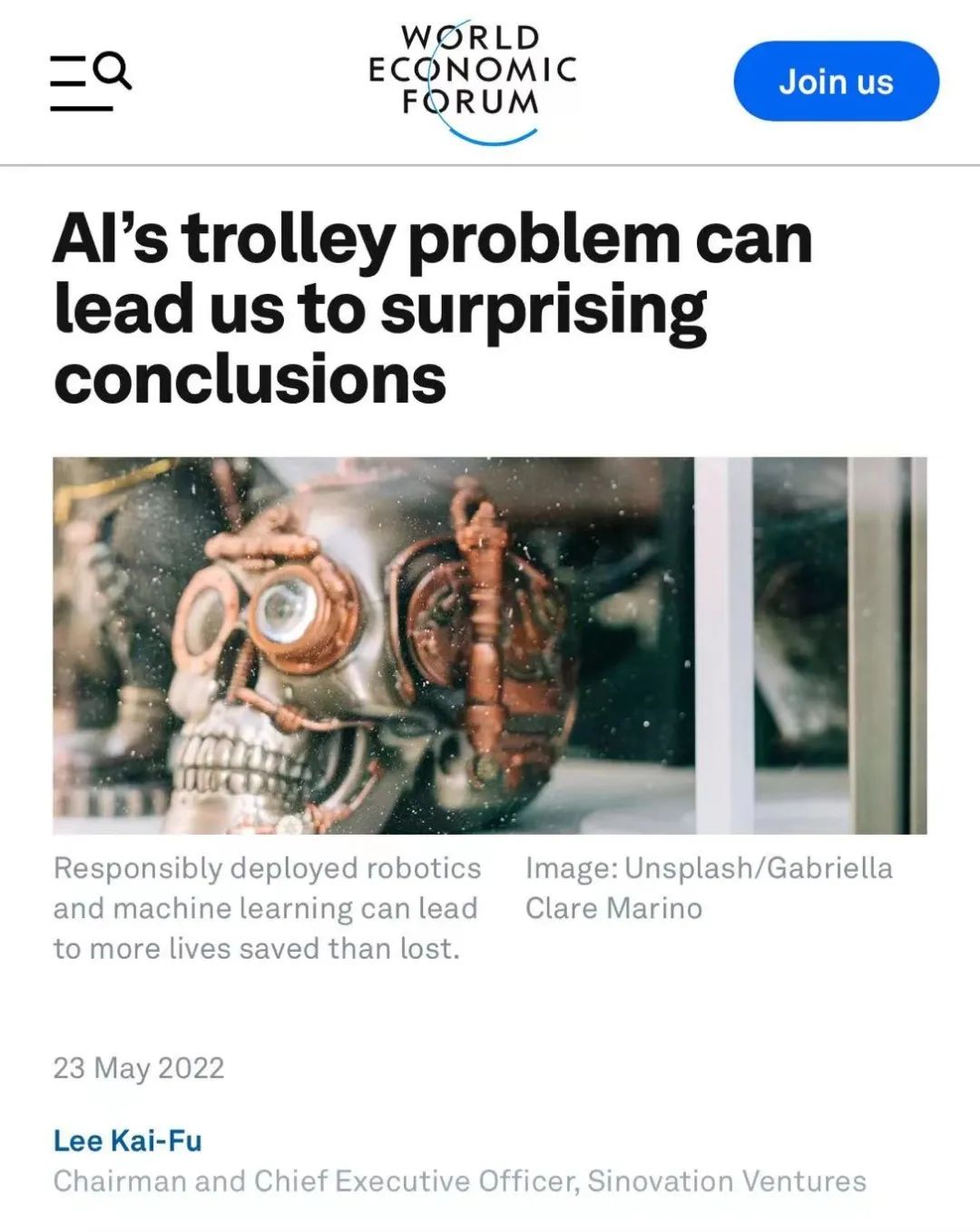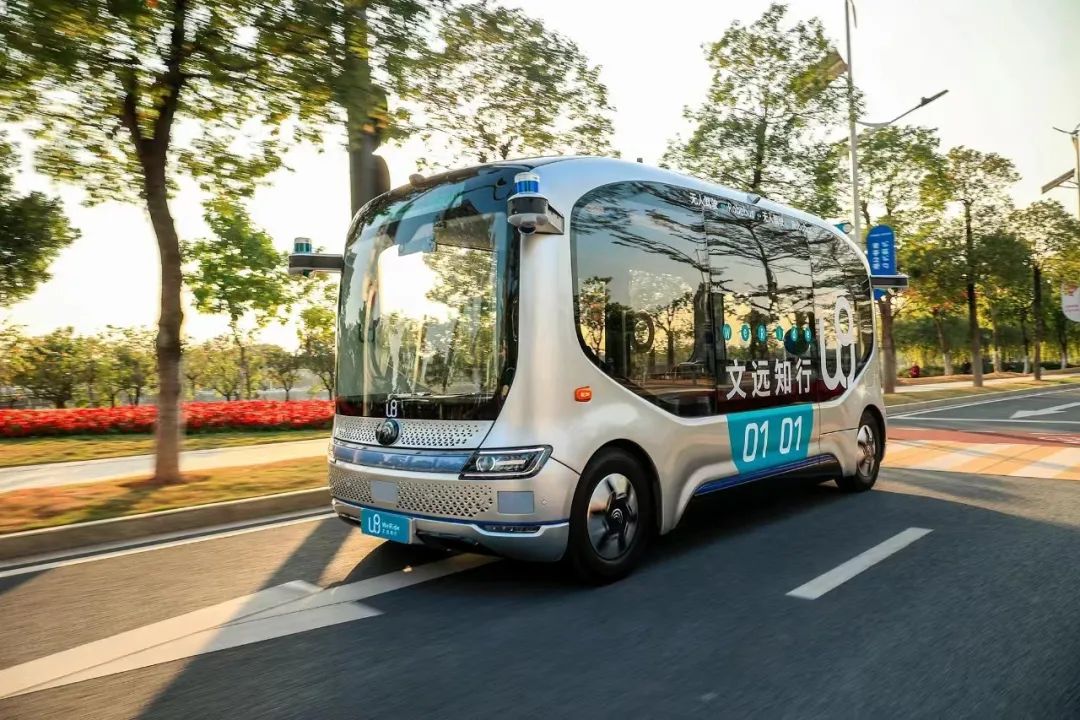划重点:
自主机器人和自主决策的确可能造成致命错误。
因机器人错误而造成的死亡,将造成道德两难的新时代“电车难题”。
如果社会接受机器学习,并竭力以负责任的态度导入机器人技术,更多生命将会因此得到拯救。

本文为创新工场董事长兼首席执行官李开复博士在本周于瑞士召开的2022年达沃斯世界经济论坛的专栏文章,经授权编译,点击文末“阅读原文”可前往专栏页面。在未来 20 年内,随着机器人技术的进步,自动驾驶汽车、工业机器人和医用机器人将拥有更强的能力、更高的自主性,并得到更为广泛的应用。
不可避免,这些自主机器人可能会犯下决策方面的错误,造成数百上千人死亡。但如果人类参与其中,这种灾难是可以避免的。 这样的未来固然可怕,不过一旦人类社会能负责任地运用机器人技术,获救的生命将多于造成的死亡。
—1—
机器学习的过程
人工智能时代的机器人并非经由人类“编程”而模仿人类的决策过程。它们从大数据中学习,利用从数据中推导出的复杂数学公式,执行诸如“识别红绿灯”之类的任务。机器学习过程需要的数据量远远超过人类所需。
然而,一旦经过训练,机器人在任何特定任务中的表现都将优于人类。借由机器学习,人工智能和机器人的性能在过去五年里已经获得了极大的提升。 我在这篇文章提出的观点适用医疗健康、制造业及其他正在快速实现自动化的行业。
先以自动驾驶为例,一位经验丰富的人类司机,一生中可能有几十万英里的驾驶经验,而谷歌旗下的自动驾驶汽车公司 Waymo,仅在 2021 年一年间就完成 230 万英里的上路测试里程,其背后的 AI 技术通过数据学习了每一辆车的驾驶经验,而且这些自动驾驶车辆永不疲劳,也不像健忘的人类司机,一不小心就会忘记他们曾经犯过的错误。
特斯拉公司的“智能召唤”功能首次推出后,汽车可以在没有车主操作的情况下,离开停车位并绕开障碍物。一开始,许多用户抱怨这个新功能表现得不尽如人意,但在短短几周内,特斯拉公司便收集了早期用户的数据,重新训练了新功能背后的机器学习模型。从此,“智能召唤”显著获得改进,成为了特斯拉新车的一大关键竞争优势。
—2—
自主机器人可以挽救生命
可供学习的数据日益增加,人工智能的能力也随之快速提升,AI 变得更精准,适应性更强,也更安全。随着越来越多的机器人进入主流日常应用,其应用领域越来越广,标志着功能性机器人技术正得到逐步普及。自动驾驶将从“握住方向盘”到“放开方向盘”,进而发展到“无需监视”,乃至“无需关注”,并最终进化到“无方向盘”的全自动状态。
中国的自动驾驶企业文远知行便是一个很好的范例。这家公司已在中国数个城市部署了无人小巴和无人环卫车。相较于无人驾驶出租车,它们在运行环境上受到了更大的限制,但与人类司机相比,安全性有了大幅提高。这些车辆在特定环境下运行并收集大量数据后,最终将摆脱这些初期上路的限制条件。
 2021年,文远知行WeRide无人小巴在广州开展测试在机器人技术从简单应用通往复杂场景的发展过程中,我们将获得更多数据,从而提升其性能和安全性。
2021年,文远知行WeRide无人小巴在广州开展测试在机器人技术从简单应用通往复杂场景的发展过程中,我们将获得更多数据,从而提升其性能和安全性。
举例来说,在未来十年里,通过减少人为失误(这是道路事故最常见的原因),自动驾驶汽车仅在英国就可以防止 47000 起严重交通事故发生,挽救 3900 人的生命。兰德公司的研究发现,即使自动驾驶的安全性仅比人类驾驶高 10%,换算过来也能够拯救许多宝贵的生命。
—3—
道德困境
对于机器人的大规模应用,大部分人仍然表现出极大的担忧,包括对机器错误导致人类丧命的道德争议。古典的“电车难题”是指一种道德困境,经典假设是旁观者可以通过切换失控电车的轨道,虽然会因此撞死一个人,却能拯救另外五个人。这一难题说明了攸关“谁生谁死“的选择,本质上是一种道德判断,这样的决策不应该交给无情的机器。
然而,机器人和人类的感知方式不同,出现的错误类型自然也就不同,这使得“道德困境”进一步加剧。举例来说,机器人反应迅捷,注意力始终集中,但可能会误判障碍物,例如优步的无人驾驶汽车就曾把推着自行车过马路的行人误判为汽车,并因此预判它比自身行进的速度更快。
人类失误和机器失误之间的差异,使得公众更加难以接受由机器人导致的死亡,如果他们曾经听闻了类似 2018 年美国凤凰城车祸事件后的媒体渲染报道,一定更难释怀。一旦各种媒体持续以谴责性的大标题,有失偏颇地放大抨击每桩自动驾驶致死的案例,那么人们很可能会对自动驾驶系统彻底失去信心,即便这项技术最终有可能拯救数百万人的生命。
若是人类司机造成他人死亡,他们将面临法律的判决并承担相应后果。但“人工智能的黑匣子”无法以人类可理解的词句,或者在法律和道德上正当合理的人类语言,向法官和公众解释肇事决策的原由。
另一点需要商榷的是问责问题。在凤凰城的那场事故中,汽车里的人类司机被指控犯有过失杀人罪。但是,在这一案件中,汽车制造商、人工智能算法供应商或工程师应该为此负责并承担一定的法律责任吗?只有问责归属明确,我们才能有共识和准则的基础来建立一个完善的自动驾驶生态系统。
—4—
人工智能和机器学习时代的“电车难题”
既然机器人技术可以挽救无数生命,那么只要证明它比人类略胜一筹,我们就有充分的理由大举推广自动化技术。
我认为,我们应把握一切机会推出对人类有助益的机器人自动化工具,它们初期应在受限制的特定环境中使用,然后再逐步规模化采用,最终获得更多自主权及更广泛的推动。通过这种循序渐进的方式,我们一方面可以收集更多的数据,提升机器人的性能,另一方面能够最大限度地降低危及人类生命的事故。
考虑到可能出现的异议,我们需要共同努力,让大众更了解机器人技术带来的短期阵痛和长期效益。只有这样,我们才能在拥抱自动化技术的进程中,逐渐培养出负责任和严谨的态度,让机器人更好地为人类社会服务。
本文经WEF世界经济论坛授权进行中文编译,原文如下:
AI’s trolley problem can lead us to surprising conclusions
Lee Kai-FuChairman and Chief Executive Officer, Sinovation Ventures
- Autonomous machines and decision-making can lead to potentially fatal errors.
- Deaths occurring due to robotic errors produce moral dilemmas, much like "the trolley problem."
- There is a case that many lives could be saved if society embraces machine learning and commits itself to deploying robotics technologies responsibly.
Advances in robotics mean autonomous vehicles, industrial robots and medical robots will be more capable, independent and pervasive over the next 20 years. Eventually, these autonomous machines could make decision-making errors that lead to hundreds of thousands of deaths, which could be avoided if humans were in the loop. Such a future is reasonably frightening but more lives would be saved than lost if society adopts robotic technologies responsibly.
The machine learning process
Robots aren’t “programmed” by humans to mimic human decision-making; they learn from large datasets to perform tasks like “recognize a red traffic light” using complex mathematical formulas induced from data. This machine learning process requires much more data than humans need. However, once trained, robots would outperform humans in any given task and AI and robotics have dramatically improved their performance over the past five years through machine learning.
We can take autonomous driving as an example, although the following theories apply to healthcare, manufacturing and other rapidly automating sectors. A seasoned human driver may have a few hundred thousand miles of driving experience overtheir lifetime but Waymo– the self-driving car company from Google – completed over 2 .3 million driven miles in 2021 alone. Its AI technologies learn from every car it deploys at once; these cars never tire and never forget lessons. When Tesla first rolled out its “smart summon” feature allowing its cars to leave a parking space and navigate around obstacles without their owner, many users complained about the poor performance. But within weeks, Tesla collected data from the early users and retrained their machine learning models. As a result, the smart summon feature’s performance improved dramatically and has become a key differentiator for Tesla.
Autonomous robotic lifesavers
With more and more data to learn from, AI is improving quickly, becoming more accurate, adaptive and safe. As the number of robots grows into mainstream daily use, so will their applications, signalling a stepwise rollout strategy for functional robotics. Autonomous driving will go from “hands-on” to“hands-off” to “eyes off” to “mind off” and eventually to “no steering wheel.” A good example is China’s WeRide. The autonomous vehicle company has deployed robo-buses and street cleaners in several cities in China.
They currently operate in more constrained environments than robo-taxis, providing substantially improved safety compared to human operators. Yet these constrained vehicles gather a tremendous amount of data, eventually freeing them of such robots move from simple to complex, more data will be collected to improve performance and safety. For example, by reducing human error (the most commoncause of road accidents), autonomous vehicles could prevent 47,000 serious accidents and save 3,900 lives in the UK alone over the next decade. RAND Corporation found that AVs will save lives even when only 10% safer than humans.
A moral dilemma
There are still major concerns around mass robotic rollout, including the moral objection to any human life being lost at all due to machine error. The trolley problem – the ethical dilemma where an onlooker can save five lives from a rogue trolley by diverting it to kill just one person – illustrates why making decisions about who lives and dies are inherently moral judgments so they can’t be relegated to unfeeling machines. This “moral dilemma” is exacerbated because robots’ and humans’ perceptions differ, resulting in different types of mistakes. For example, robots have lightning reflexes with unflinching attention but can misidentify hazards, such as when an Uber self-driving car took a pedestrian dragging a bicycle across the road to be a car, expecting it to travel faster than it was.
The disparity between human and machine errors makes public acceptance of deaths from robots harder, especially if each one is met by the same media reaction as the 2018 fatality in Phoenix received. If the media disproportionately condemns every robot-induced death with damning headlines it has the potential to destroy confidence in autonomous systems, despite the technology’s potential to save millions of lives. When human drivers cause fatalities, they face judgment and consequences under the law. But the “black box of AI” can’t explain its decision-making in humanly comprehensible or legally and morally justifiable terms to a judge and the public. Another issue is accountability. In the Phoenix case, the human backup driver was charged with negligible homicide. But is there a case for the car manufacturer, AI algorithm provider or engineer who wrote the algorithm to be responsible and liable? Only when accountability is clear can an ecosystem be built around it.
The trolly problem in the age of AI and machine learning
Because many lives could be saved, there’s an argument for launching robotic technologies once proven to be slightly better than people. Thus, every opportunity should be taken to launch robotic tools that assist humans before robots are given more autonomy. Then, their rollout should be within constrained environments before being available more widely.
Doing so, in this way, will allow more data to be gathered, improving the robotic performance and minimizing the number of lives lost. Given the likely objections, we need to work on communicating the short-term pain collectively and the long-term gain involved. Doing so will enable us to work towards a responsible and thoughtful rollout of robotics so that this adoption process brings greater good to humankind.
0
推荐




 京公网安备 11010502034662号
京公网安备 11010502034662号 